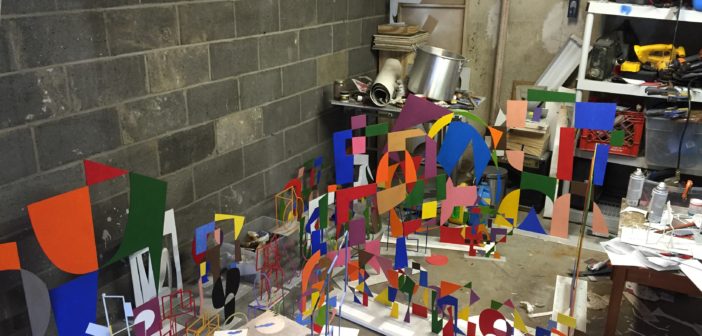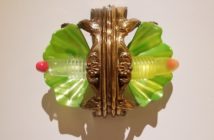A collection of small, bright sculptures by Alexi Antoniadis are visible through the back windows of Carroll & Sons on Harrison Avenue in Boston. Seeming weightless from their perches on subtle shelving, with vibrant colors and taut shapes, they possess somehow both vintage and futuristic qualities. Last summer, two of the larger sculptures, at three feet high, were part of the group exhibition “No Boys Allowed,” with Robin Dash, William DiBello, Gail Fitzgerald, Alicia Gibson, Monique Johannet, Martin McDermott, Carl Ostendarp, Sheila Pepe, and Gary Petersen. Vivacious, formal, and at times floppy, this summertime show had verve and wit. Taking its title from the words scrawled in a painting by Alicia Gibson, the exhibition brought on rich, organic possibilities in contemporary abstraction. This phrase, “No Boys Allowed,” set the tone for the many works that brought a feminist response to late 20th century abstraction, particularly Sheila Pepe’s immense crochet work, Corner Piece Redux, and Monique Johannet’s painting, “Joan Miro,” that riffed on Roy Lichtenstein’s Pop style. In the context of this exhibition, Antoniadis’ sculptures brought vulnerable strength with edges cut in steel, but softened by his hand-cut lines and painted with saturated colors.
Antoniadis created this steadily accumulating group of small-scale sculptures (thirteen at Carroll and Sons), and many more in his studio, that make statements about space, focus on one material (steel), and invite gorgeous shadows. We talked about negotiating the inheritance of modernism, how to get out of one’s own way in order to create mature, intuitive work, and about his first series shown publicly after nearly a decade as one half of the collaborative team, Antoniadis & Stone. New works demonstrate his strengths as a formalist, and show the fruits of diving into a drawing-driven sculptural practice.
Shana Dumont Garr: Seeing your sculptures in person now, I like the human touch I see on the flat planes, the textures on the surface, and I’m sure that’s no accident.
Alexi Antoniadis: No it’s not, including the cutting of the steel. There are certain limitations with the tools that I use, and that is just the beginning. I start with drawings that are spatial, conceptual sketches. I refer to the drawings as I cut the steel, allow for imperfections, and then I don’t worry too much about refining the drawing. I am into high output and maintaining a creative flow. I don’t linger on them too long, so I’m not very careful. It really is an exploration, a constant push, no one thing considered too precious. I made so many flat ones, and then I had 30 of them, and that forced me to ask myself, “what else could I do in this format-where else could I go”?
SDG: I see what you mean - some of these inhabit shallow space, almost like components of a stage set or diorama backdrops.
AA: They are all frontally oriented, and function like drawings and paintings in that way. I am a frustrated painter. That’s what I went to school for, but painting on canvas didn’t always work for me that well. After school I moved towards collage, and then more materials, less paint.
SDG: So your transition from painting to sculpture was with assemblage?
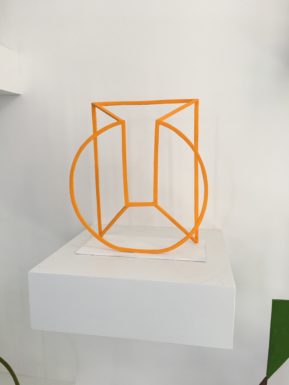
Alexi Antoniadis at Carroll and Sons.
AA: Yes. I always wanted to work with materials, tackling painterly concerns….I am present with the work and the process is an unfolding progression. I think it’s important to exhaust an idea, to search to the end. That exhaustion point may not be shown in the gallery, but I want to take it there as it will inform new discoveries.
SDG: I like the focus, pushing to create with these limitations. How did your current series come together--are they a single series, or two different series?
AA: They are one series together, complementing each other. The linear pieces function as three-dimensional drawings, while the flat pieces provide more of an illusionary or painterly space where the colors push and pull against negative space. They work together as parts of the same exploration that is still in process.
SDG: Is this series partly about you talking with influential artists?
AA: Yes, maybe not individual artists, but even when I worked with Nico [Stone] in our partnership of Antoniadis & Stone, it was. We referenced art historical modes a lot, but in a more conceptual, critical way, and now this is more formal and less critical.
SDG: How long did you collaborate with Nico Stone?
AA: About eight years, and we may again in the future. I do miss the scale, the drama, but right now I like the idea of collections and series. The work I made with Antoniadis and Stone was big, cumbersome, threatening and dramatic, but it was all fake, while in contrast, these small sculptures are what they are. These are real: that’s a real, yellow triangle. It’s a different thing. They are about color, shapes, and lines. Whatever feelings these pieces evoke are on a direct level, while A&S had a psycho/social layer to it too.
SDG: Yes, my memory of your work as Antoniadis and Stone is about surrealism. My epiphanies as a viewer were as though realized in a dream. Has anyone placed a story or narrative on one of the sculptures? I mean, there is drama. The cross for example seems to radiate or breathe as I look at it.
AA: No one has applied narrative on these. I think they defy that temptation. These are more essential. I think that the formal quality of the drawing you’re talking about, the sensual feeling, that’s the concept which replaces narrative.
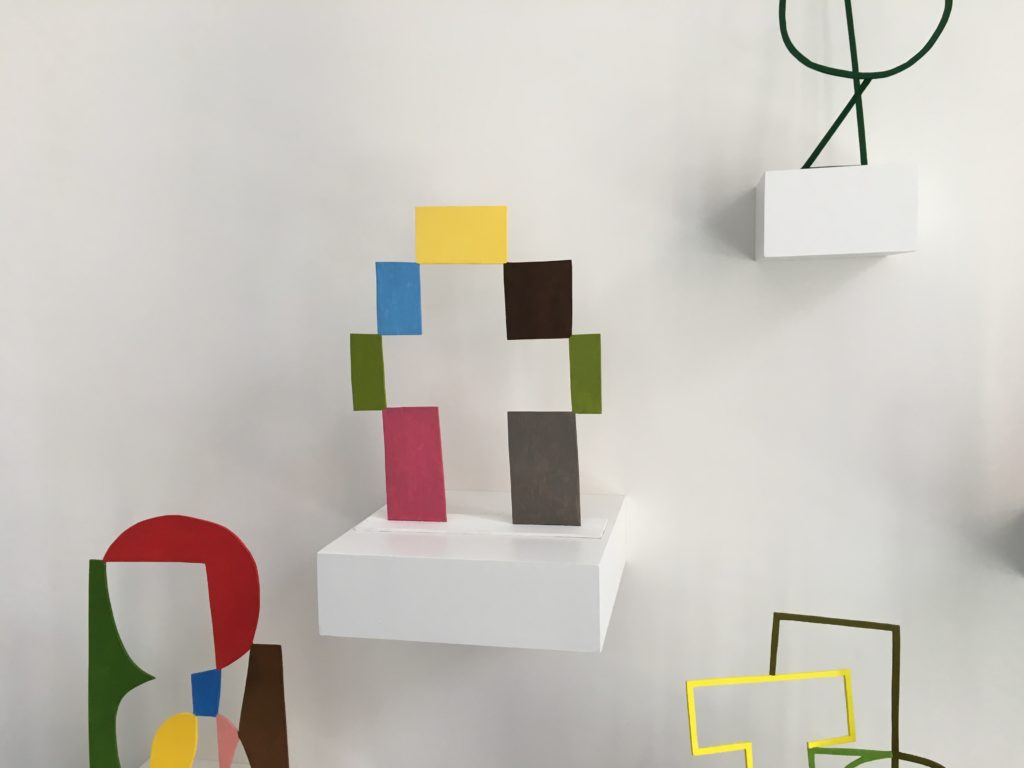
Alexi Antoniadis at Carroll and Sons.
SDG: I see such a conversation with mid-century modernism. What are you bringing from 2016?
AA: Earlier in my career, I wouldn’t have risked making this kind of work in order to prevent questions like that. And, while what I bring today cannot add and contribute to that tradition because it has evolved, branched off and become our post-modern moment, I believe the act of re-looking inevitably brings something new. There’s a certain throw-back element, that I suppose I would’ve been insecure about when I was shooting for newness and innovation. The job of a contemporary artist is to set one’s self apart from everyone else. That assignment is great, if that’s genuinely what you want. Focusing on shape and color is modernist. So if that’s what you do, it’ll resemble that. There’s a certain amount of what we want to say with our work, but then there is what comes out of us naturally, and then we deal with how the two combine. I think the past is always informing the present, and the contemporary tendency is to reform the past and to be critical of it. Without a doubt, there’s a certain amount of rejection of the past that needs to happen in order to move forward. But, then there’s a part that embraces the past. Like with rock and roll, a band like the Strokes came out and did this thing that sounded vintage, but meanwhile it was great AND new and re-sparked a whole movement. We all work with art of the past, but how? By rejecting, by embracing parts of it, by mimicking and subverting it to show how chauvinist art was back in the day? There are many contexts for how you can work within a tradition. Even if my work doesn’t appear to critique or grapple with earlier art, it is contemporary in refusing to do so.
SDG: You are grappling with formalism at a time when it’s not shocking to not have something be representation. It isn’t part of what you’re opposing, or be part of the subject matter, as it has been done for decades.
AA: When I was in art school, it was a no-no to work with straight shapes, colors, and forms. I wanted to paint Cubist stuff, and I was discouraged by my professors. It was seen as a dead end. But I don’t believe in dead ends if the exploration is authentic. If you make it today, it is unique in its own context. I see this in a lot of younger artists, a decade or so behind me, they shamelessly grab stuff from the past. I see it with painters: “I’m going to paint like COBRA”. I used to think they couldn’t do that, but there’s been a shift in my outlook and perhaps in our current art culture. Why can’t they do that? Everything is available to us all the time. We can pick and choose modes. It’s up to us to make it serious when we make that choice.
SDG: I like how some of them could be read as a critique of logos. When you were born in the 70s and you come of age and realize through art education, some things could’ve gone a totally different way -Intense being with the materials, color, and space, the drama side, but from a critique side that’s a logo but it’s not, it has the hand feel. Not mass-produced, or fabricated in silicone.
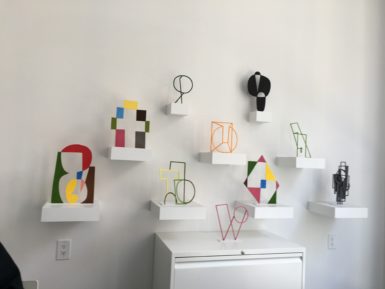
Alexi Antoniadis at Carroll and Sons.
AA: They do have a graphic quality. When I started out on these, I tried to produce a couple of pieces with digital drawing and water-jet, the same tools that might produce commercial signage or logos. The hand was lost, and it was no good.
SDG: That is so meta: the digital hand.
AA: It has to be something that I’m figuring out myself: an immediacy between me and the materials.
SDG: The results are consistently so formal that I’m not seeing figures, not anthropomorphizing them. They resist that, and it makes the pieces more contemplative and meditative.
AA: I try not to reference anything. The meditative is a huge part of the process, occupying a non-representational space, responding directly to the things I’m working on with without bringing in reference as an anchor.
The original modernists were revolutionary with grand gestures bold statements about their work. They wanted to change the world with their art. These romantic and progressive aspects of modernism are over and perhaps were invalid to begin with, but no matter what, there is a certain magical element in the handling of materials that I think is undeniable and has been part of art making since pre-history. So for me it’s intuitive but not a declaration. I’m letting the work perform when it’s doing something and it’s good.
SDG: Do you have questions about what whether the finished work has a similar effect on people as it has on you as you make it?
AA: I want people to see what I see. I embrace the pleasure of making and composing, and in turn that pleasure is accessible to viewers. I’m not sure you have to challenge viewers in order to get their attention. With Nico we certainly did and it worked! With that work it was necessary, but keeping pleasure as one of the hooks: that’s something that I’m into now.
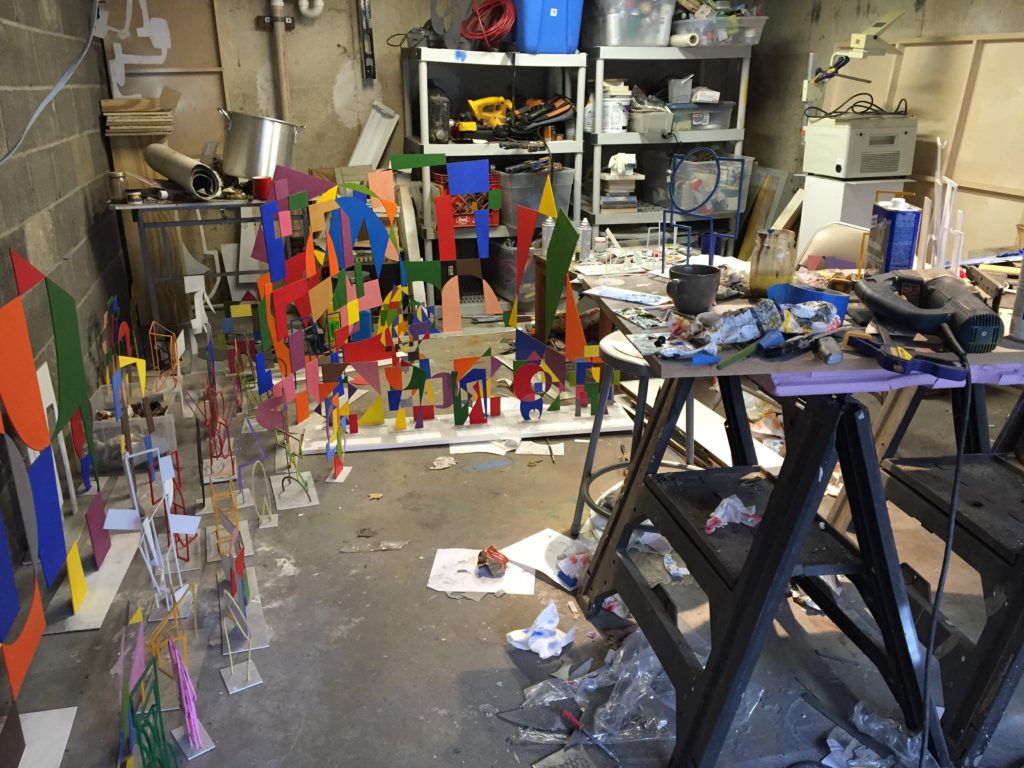
Alexi Antoniadis's studio.
SDG: It sounds like you’ve worked to earn the permission, at first needing to prove that you could be fully original, but then coming full-circle to say that you feel good about being creative in this way.
AA: Totally. Earning it. I think about artists as they evolve through the years. It always goes back to music for me, and I’m thinking of later Lou Reed or Bob Dylan. When you’re young, you want the Velvet Underground. I have always been drawn to the later Frank Black after the Pixies. That’s when they settle down and did their shit--did what they wanted regardless of the current zeitgeist. There’s a real satisfaction in that. I find that all things turn to standards if they are potent. When you do something new when you’re young, creatively, you do it with a youthful energy, but there are those big standards we’re all standing on. You can fall in love with those again.
SDG: Implied in that is the presence of play. Because it’s familiar, it is enjoyable. There is softness, and yet still precision, after much practice. The work makes connections, brings things together where they may have been considered separate.
AA: That’s right; I find ease in the making. Too much effort can be your enemy in the studio. But that depends on your process and goals. With a more project-based process, like I had with Antoniadis and Stone, we had to harness effort to meet a goal, and it was a more energetic way to work. But nowadays I’m more zen-like. I put in 70% effort and maintain flow. That’s the big distinction between the two practices for me. It’s not a boxing match in the studio.

